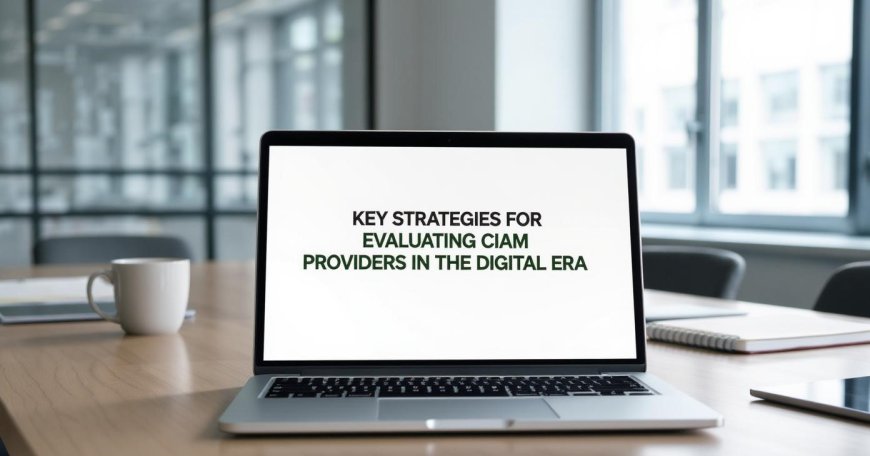Key Strategies for Evaluating CIAM Providers in the Digital Era
As digital ecosystems expand, businesses must safeguard customer identities while delivering frictionless access across channels. Customer Identity and Access Management (CIAM) is no longer a luxury—it is a necessity. At Bizinfopro, we recognize that the best practices for evaluating CIAM providers are essential for ensuring secure, scalable, and user-friendly identity platforms that meet both compliance and customer expectations.

As digital ecosystems expand, businesses must safeguard customer identities while delivering frictionless access across channels. Customer Identity and Access Management (CIAM) is no longer a luxuryit is a necessity. At Bizinfopro, we recognize that the best practices for evaluating CIAM providers are essential for ensuring secure, scalable, and user-friendly identity platforms that meet both compliance and customer expectations.
Understanding CIAM's Strategic Value
Customer Identity and Access Management enables enterprises to securely manage customer logins, profile data, consent, and authentication while maintaining seamless digital experiences. The best practices for evaluating CIAM providers require enterprises to treat CIAM not just as a tool, but as a strategic enabler of trust, personalization, and compliance.
The right CIAM solution enhances data governance, customer experience, and brand securityall critical pillars of digital transformation.
Define Your Identity Strategy Before Evaluation
Before assessing vendors, clearly define your CIAM goals. Ask:
-
What is the size and growth rate of your customer base?
-
Are you targeting B2C, B2B, or B2B2C models?
-
What regulatory environments are you subject to (GDPR, CCPA, HIPAA)?
-
What authentication experiences are you aiming for?
One of the best practices for evaluating CIAM providers is aligning vendor capabilities with these goals. A misaligned provider can introduce integration delays, poor customer experience, or non-compliance risks.
Assess Data Privacy and Compliance Readiness
A CIAM provider must be capable of meeting strict data protection standards. Leading vendors should support:
-
Built-in GDPR and CCPA compliance tools
-
Consent management dashboards
-
Audit trails and data subject access requests (DSARs)
-
Data minimization and purpose limitation features
One of the best practices for evaluating CIAM providers is verifying compliance features during demos and requesting documentation on certifications like ISO 27001, SOC 2, and FedRAMP.
Ensure Seamless User Experience and Brand Control
Customers expect intuitive, secure access experiences. When evaluating CIAM providers, test for:
-
Frictionless sign-up/login
-
Social identity federation
-
Multi-device session continuity
-
Embedded self-service portals
-
Customizable UI/UX
The best practices for evaluating CIAM providers include testing demo environments for actual user journeys and measuring registration time, error rates, and mobile responsiveness.
Evaluate Multi-Factor Authentication Capabilities
Modern CIAM platforms must support a wide variety of MFA methods to prevent credential-based attacks. Look for:
-
Email/SMS-based one-time passwords
-
Authenticator apps
-
Biometrics
-
Adaptive or risk-based authentication
The best practices for evaluating CIAM providers recommend ensuring the MFA system is extensible and does not compromise usability.
Investigate API and Integration Flexibility
A key priority in CIAM evaluation is integration with your current tech stack. Your chosen provider must offer APIs and SDKs for:
-
CRM and marketing automation systems
-
Mobile apps and IoT platforms
-
Cloud-native infrastructure and DevOps tools
-
Data lakes and analytics tools
The best practices for evaluating CIAM providers call for open standards (OAuth 2.0, SAML, OpenID Connect) and developer-friendly documentation.
Scalability and High Availability Architecture
Scalability is non-negotiable. Ask providers about:
-
Their highest concurrent user loads
-
How they handle global traffic routing
-
Failover mechanisms and disaster recovery
-
Peak load performance reports
The best practices for evaluating CIAM providers emphasize understanding the underlying cloud architecturebe it multi-tenant SaaS, hybrid deployment, or private cloud.
Audit Security Posture and Incident Response Protocols
CIAM providers should operate with a proactive security-first approach. Evaluate:
-
How data is encrypted at rest and in transit
-
Passwordless readiness and key rotation policies
-
Penetration testing frequency
-
Incident response and notification procedures
-
Internal security certifications for engineering teams
According to the best practices for evaluating CIAM providers, its also crucial to examine third-party security audit results.
Analyze Reporting, Monitoring, and Insights
A robust CIAM platform should give you deep visibility into:
-
Login activity and suspicious logins
-
Consent and profile management actions
-
Identity federation sources
-
Audit logs for access and administration
When following best practices for evaluating CIAM providers, look for real-time analytics dashboards and pre-built compliance reports that support your business intelligence.
Understand Vendor Lock-In and Exit Strategy
Evaluate the long-term implications of working with any CIAM provider. Consider:
-
Data portability options
-
Open standards adoption
-
Customization versus configuration balance
-
Migration support services
Among the best practices for evaluating CIAM providers, avoiding vendor lock-in is crucial for maintaining IT agility and strategic freedom.
Compare Support, SLA, and Global Coverage
Support and uptime are critical. Ask each provider for:
-
Their SLA coverage
-
Dedicated support models
-
Knowledge base and training material
-
Global infrastructure locations
The best practices for evaluating CIAM providers recommend testing customer support channels and gauging their real-world response times before signing contracts.
Consider Innovation and Future-Readiness
Your CIAM provider should evolve with your business and the broader technology landscape. Key innovations to watch for include:
-
Decentralized identity (DID) and blockchain
-
AI-powered fraud detection
-
Passwordless authentication and biometrics
-
Behavioral analytics
-
Consent orchestration frameworks
Following the best practices for evaluating CIAM providers, ensure the vendors roadmap aligns with your digital transformation journey.
Perform Real-World Testing and PoCs
Theory and demos aren't enough. Run Proof-of-Concept (PoC) scenarios with your top shortlisted vendors. Simulate:
-
Real-time logins with 100,000+ users
-
MFA experiences on mobile and desktop
-
Identity federation across systems
-
Consent withdrawal and profile deletion
Live testing is one of the most practical best practices for evaluating CIAM providers that exposes implementation gaps early.
Collaborate with Cross-Functional Teams
A CIAM decision shouldnt rest with IT alone. Assemble a CIAM evaluation taskforce including:
-
Legal and compliance officers
-
Marketing and customer experience leads
-
Security and data governance teams
-
Frontend and backend developers
The best practices for evaluating CIAM providers involve inclusive decision-making to ensure the solution meets both technical and business goals.
Read Full Article : https://bizinfopro.com/webinars/best-practices-for-evaluating-ciam-providers/
About Us : BizInfoPro is a modern business publication designed to inform, inspire, and empower decision-makers, entrepreneurs, and forward-thinking professionals. With a focus on practical insights and in?depth analysis, it explores the evolving landscape of global businesscovering emerging markets, industry innovations, strategic growth opportunities, and actionable content that supports smarter decision?making.

































